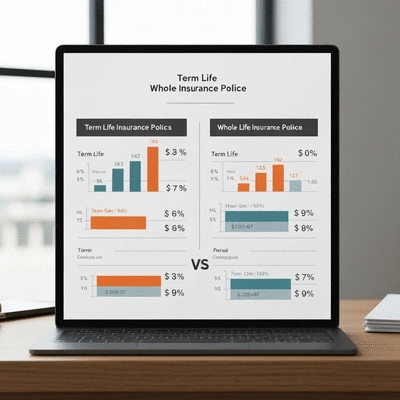Term vs Whole Life Insurance

When considering life insurance, understanding the differences between term and whole life insurance is crucial for making an informed decision. Let's explore the key insights that will help you choose the right policy for your financial goals.
What You Will Learn
- Term life insurance provides coverage for a specified period, making it ideal for temporary financial needs.
- Whole life insurance offers lifelong coverage and builds cash value over time, serving as both protection and an investment.
- Understanding the cost differences is essential: term life typically has lower premiums, while whole life premiums are higher due to cash value benefits.
- Evaluate your financial goals: do you need short-term security or long-term investment growth with your policy?
- Consulting with professionals can provide tailored advice, helping you navigate policy options that best fit your situation.
Term Life vs. Whole Life Insurance: Key Differences
A side-by-side comparison of the two primary types of life insurance to help you make an informed decision.
Term Life Insurance
Provides coverage for a specific period (e.g., 10-30 years).
- ✓ Coverage Duration: Temporary (10-30 years)
- ✓ Cost: Typically lower premiums
- ✓ Cash Value: None
- ✓ Death Benefit: Paid only if death occurs during the term
- ✓ Ideal For: Temporary needs like mortgages or raising children
Whole Life Insurance
Provides lifelong coverage and builds cash value over time.
- ✓ Coverage Duration: Permanent (entire lifetime)
- ✓ Cost: Higher, consistent premiums
- ✓ Cash Value: Accumulates at a guaranteed rate, can be accessed
- ✓ Death Benefit: Guaranteed, regardless of when death occurs
- ✓ Ideal For: Lifelong protection and wealth accumulation
Understanding the Basics: Term Life vs Whole Life Insurance
Navigating the world of life insurance can feel overwhelming, but once you grasp the basics, it becomes much clearer. In this section, we're diving into two primary types of life insurance: term life and whole life. Each serves different purposes, and understanding them is essential for making the right choice for your financial future!
What is Term Life Insurance?
Term life insurance is designed to provide financial protection for a specified period, typically ranging from 10 to 30 years. If the policyholder passes away during this term, the beneficiaries receive a death benefit. It's a straightforward and often more affordable option, making it ideal for those who need coverage for a specific period, like raising children or paying off a mortgage.
- Affordable premiums compared to whole life.
- Covers you for a set period—ideal for temporary needs.
- No cash value accumulation; benefits are paid only upon death during the term.
By choosing term life insurance, you can obtain significant coverage at a lower cost, allowing you to allocate funds to other financial goals. However, it’s essential to consider what happens once the term expires. Are you prepared for potential increases in premiums or the need for new coverage? A study on life insurance decision-making highlights the importance of understanding these implications.
What is Whole Life Insurance?
Whole life insurance provides coverage for your entire lifetime, as long as you continue to pay the premiums. Unlike term life, whole life policies build cash value over time, which can be borrowed against or withdrawn. This feature makes whole life insurance not only a protection tool but also a long-term financial asset.
- Guaranteed death benefit, irrespective of when you pass away.
- Cash value accumulation that grows at a guaranteed rate.
- Higher premiums compared to term life but provides lifelong coverage.
With whole life insurance, you’re investing in a policy that can serve multiple purposes throughout your financial journey. Think of it as both a safety net and a savings tool! However, it’s crucial to weigh the benefits against the higher costs to determine if it aligns with your financial strategy. Research from PMC NCBI explores the broader benefits of life insurance in promoting health and financial well-being.
Key Differences Between Term Life and Whole Life Insurance
Understanding the differences between term life and whole life insurance can help you make an informed decision that aligns with your financial goals. Let’s explore some of the key distinctions!
Coverage Duration: Temporary vs Permanent Protection
The first and most significant difference lies in coverage duration. Term life insurance is temporary. It covers you only for a certain period, while whole life insurance offers permanent protection. This distinction is vital when considering how long you need coverage for your dependents or financial obligations.
- Term Life: Coverage lasts for a specified term (e.g., 10, 20, or 30 years).
- Whole Life: Coverage lasts for your entire life.
Identifying your specific needs is essential. Are you looking for short-term coverage to protect your family during critical years? Or do you want lifetime protection that builds cash value? A study from Ohio State University provides guidance on choosing between term and permanent life insurance based on individual circumstances.
Cost Comparison: Which Insurance Fits Your Budget?
Cost plays a significant role in choosing between term and whole life insurance. Generally, term life insurance comes with lower premiums, making it an accessible option for many families.
- Term Life: Typically lower premiums, ideal for budget-conscious individuals.
- Whole Life: Higher premiums due to the cash value component and lifelong coverage.
When evaluating costs, consider your current financial situation and future objectives. Would you prefer a more affordable term life policy that you can convert later, or can you invest in the more expensive whole life policy from the start?
Cash Value Accumulation Explained
Cash value accumulation is a crucial feature of whole life insurance that distinguishes it from term life insurance. With whole life, part of your premium goes into a cash value account that grows over time. This cash value can be accessed or borrowed against, providing a potential source of funds in emergencies.
- Whole Life: Cash value grows at a guaranteed rate and can be withdrawn or borrowed.
- Term Life: No cash value; benefits are paid only upon death.
This feature can be beneficial for long-term financial planning. However, it’s essential to keep in mind that accessing cash value can reduce the death benefit.

Death Benefits: What to Expect from Each Policy
Understanding the death benefits of term and whole life insurance is vital. With term life insurance, your beneficiaries receive a death benefit if you pass away during the policy term. On the other hand, whole life insurance guarantees a death benefit regardless of when you pass, provided premiums are paid.
- Term Life: Death benefit paid only if death occurs during the term.
- Whole Life: Death benefit paid at any time, plus cash value accumulation.
This difference can greatly impact your family's financial security. Which option aligns better with your vision for their future?
Understanding Insurance Premiums: How They Affect Your Policy
Finally, it’s crucial to understand how insurance premiums work. Term life policies usually offer lower premiums, while whole life premiums are higher but fixed for the life of the policy. This can greatly influence your budget and financial plans.
- Term Life: Initial premiums are low, but can increase significantly at renewal.
- Whole Life: Higher, consistent premiums that build cash value over time.
Evaluating your current income, future earning potential, and financial responsibilities can help you choose the right policy. I encourage you to think about your long-term financial health and how each option fits into your plans!
Frequently Asked Questions About Life Insurance
What is the main difference between term and whole life insurance?
Term life insurance covers you for a specific period (e.g., 10-30 years) and typically has lower premiums, but no cash value. Whole life insurance offers lifelong coverage, builds cash value over time, and has higher, consistent premiums.
Which type of life insurance is more affordable?
Term life insurance generally has lower premiums compared to whole life insurance, making it a more affordable option for many individuals and families, especially for temporary financial needs.
Does term life insurance have cash value?
No, term life insurance does not accumulate cash value. Its primary purpose is to provide a death benefit if the insured passes away within the specified term.
Can I borrow against my whole life insurance policy?
Yes, whole life insurance policies build cash value that can be borrowed against or withdrawn. However, accessing the cash value may reduce the death benefit if the loan is not repaid.
When should I consider term life insurance versus whole life insurance?
Term life is ideal for temporary needs like covering a mortgage or raising children, where coverage is needed for a specific period. Whole life is better for lifelong protection, wealth accumulation, and ensuring a guaranteed death benefit regardless of when death occurs.
What are riders and how do they enhance a life insurance policy?
Riders are additional benefits that can be added to a life insurance policy to customize coverage. Examples include accidental death benefit, child rider, waiver of premium, and terminal illness rider, which provide extra protection or flexibility for specific situations.
We Want to Hear From You!
Which type of life insurance do you think better suits your needs? Share your thoughts below:
Summarizing the Best Insurance Options Based on Financial Goals
When it comes to choosing the right life insurance policy, aligning your selection with your financial objectives is crucial. Different policies serve varying needs, and it's essential to identify what matters most to you and your family. From protecting loved ones to accumulating wealth, understanding your goals can guide you in making informed choices.
Here are some key factors to consider when selecting an insurance policy:
- Financial Security: Is your primary goal to ensure your family's financial stability in case of your untimely passing?
- Investment Growth: Are you looking for a policy that builds cash value over time?
- Flexibility: Do you need a policy that allows you to adjust coverage as your life circumstances change?
- Affordability: What are you willing to pay in premiums while still meeting your other financial obligations?
By answering these questions, you can narrow down whether a term life or whole life insurance policy is the best fit for your unique situation. At Life Insurance Internet, we emphasize the importance of having a clear understanding of your financial objectives as you navigate your options!

Which Insurance Policy Aligns with Your Financial Objectives?
When it comes to aligning your life insurance with financial objectives, each type of policy brings distinct advantages. For instance, term life insurance is often ideal for individuals seeking affordable coverage that lasts for a specific period, making it excellent for temporary financial needs like raising children or paying off a mortgage. On the other hand, whole life insurance provides lifelong protection and serves as an investment vehicle that builds cash value over time.
- Term Life: Best for short-term goals and lower premium costs.
- Whole Life: Offers lifelong coverage and cash value accumulation.
- Universal Life: Provides flexible premiums and death benefits.
- Variable Life: Allows investment choices for potential growth.
Ultimately, the policy that aligns with your objectives depends on your current financial situation and future aspirations. I often encourage my clients to reflect on what they hope to achieve with their life insurance—this is key to making the right decision!
Next Steps: Consulting with Insurance Professionals for Tailored Advice
Once you’ve identified your objectives, the next step is to consult with an insurance professional. Speaking with an expert can provide tailored insights based on your needs and financial situation. Whether you reach out to a licensed insurance broker or a financial advisor, their expertise can help you understand the nuances of different policies and guide you toward options that best suit your goals.
- Schedule a meeting with an insurance advisor to discuss your needs.
- Ask about different policy options and their benefits.
- Request quotes to compare costs and coverage.
- Consider any riders or additional features that might enhance your policy.
Engaging with professionals ensures that you are equipped with information that is not only accurate but also aligned with your financial future. Remember, the right advice can make all the difference in securing a policy that supports your long-term goals!
Evaluating the Role of Riders and Additional Benefits in Your Policy
Riders and additional benefits can significantly enhance your life insurance policy. These options allow you to customize coverage and address specific needs that standard policies may not cover. For instance, adding a critical illness rider can provide a payout if you're diagnosed with a severe health condition, offering additional peace of mind.
- Accidental Death Benefit: Provides extra coverage for deaths resulting from accidents.
- Child Rider: Covers your children under your policy for a nominal fee.
- Waiver of Premium: Waives premiums if you become disabled.
- Terminal Illness Rider: Allows access to death benefits if diagnosed with a terminal illness.
When selecting riders, think about your lifestyle, health conditions, and future needs. As a financial educator with over a decade of experience, I’ve seen firsthand how these enhancements can provide crucial support for families during challenging times. Investing in additional benefits can help tailor your policy to truly reflect your family's needs!
Recap of Key Points
Here is a quick recap of the important points discussed in the article:
- Term Life Insurance: Provides coverage for a specified period (typically 10-30 years) with affordable premiums, but no cash value accumulation.
- Whole Life Insurance: Offers lifetime coverage and accumulates cash value over time, but comes with higher premiums.
- Coverage Duration: Term life is temporary, while whole life is permanent, affecting long-term financial planning.
- Cost Considerations: Term life is generally more budget-friendly; whole life serves as both insurance and an investment.
- Cash Value Accumulation: Only applicable to whole life policies, providing a source of funds in emergencies.
- Consult with Professionals: Engaging with an insurance advisor can help tailor your policy to meet specific financial needs.








